Meet the Species
The Marine Mammal Rescue Team responds to reports of all marine mammals in New Hampshire, however, harbor seals are seen most often because it is normal for them to haul out on the beach to rest, nurse, or soak up the sun. The seal species seen in NH's coastal region are gray, harp, and hooded. Whales, harbor porpoises, and atlantic white sided dolphins frequent the Gulf of Maine, but rarely strand on the beach.
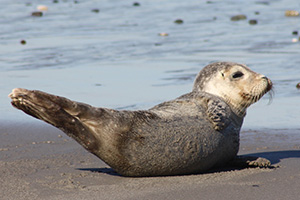 Harbor Seal (Phoca vitulina) Harbor Seal (Phoca vitulina)
Harbor seals are the most common species seen in New Hampshire. This is because they are year round residents of the east coast and they commonly haul out on land. The distinguishing feature of the harbor seal is a short, blunt dog-like snout. Their coloring varies but they are generally a light to dark gray with darker spotting. When hauled out on land, they tend to rest in a “banana-like” position, elevating their head and hind flippers. Males are generally larger than females, measuring approximately 6 feet and weighing up to 245 pounds. Females give birth in our area May-June and pups wean from their mother after 3-4 weeks. Harbor seal pups can swim shortly after birth and can dive for up to 2 minutes when they are just 2-3 days old. Photo courtesy of New England Aquarium
Gray Seal (Halichoerus grypus)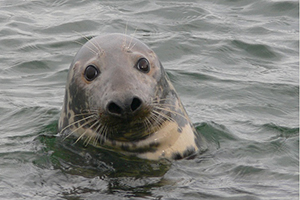
Gray seals are also seen in New Hampshire year round. The distinguishing feature of the gray seal is its long snout, which is why they are sometimes referred to as “horseheads”. Gray seals are much larger than harbor seals and male gray seals are significantly larger than females. Males can reach up to 10 feet in length and can weigh in at a hefty 880 pounds. Females can reach up to 7.5 feet and 550 pounds. Females give birth north of New Hampshire in Maine and the Canadian Provinces January-February. Pups are born with a creamy white coat that they shed for their adult coat after 2-3 weeks and they wean from their mother after 2-3 weeks. The coat of an adult female is a silver-gray color with dark spots and males have a dark gray coat with lighter spots. Gray seals can hold their breath for over an hour. Photo by R.E.Johnson
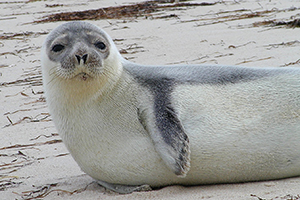 Hooded Seal (Cystophora cristata) Hooded Seal (Cystophora cristata)
Hooded seals are considered ice seals and are typically only seen in New Hampshire during the winter months and are generally more territorial and aggressive than other seals. Male hooded seals are easily distinguished from females and other seals because of the inflatable sac on their head, which extends from the crown of their head to their upper lip. This “hood” is inflated to attract females’ attention during mating season and to establish dominance and display hostility toward other males. Males are larger than females, measuring 8 feet and weighing up to 660 pounds, while females are 7 feet and 440 pounds. Females give birth on pack ice and pups are often referred to as “bluebacks” because their coat is a blue-gray on the back with a whitish belly. They shed this coat after approximately 14 months, when they molt to their adult coat which is a gray coat with dark irregular blotches and a dark head. Pups are weaned after only 3-4 days, the shortest weaning period of any mammal, and during these first few days their body weight nearly doubles! Photo by R.E.Johnson
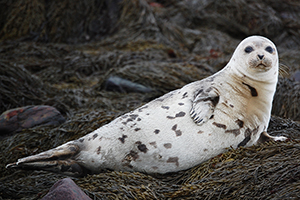
Harp Seal (Pagophilus groenlandica)
Harp seals are also ice seals and are typically only seen in New Hampshire during the winter. Their distinguishing feature is the dark harp-like shape on the coat of adults. Adult harp seals are approximately 5-6 feet long and weigh around 300 pounds. Females give birth on pack ice late February-March. Harp seal pups are distinctive for their all white coat that has long wool-like fur, called lanugo. They go through a series of molts and the coat of an older pup will be a gray-tan with darker spots, before they achieve their adult coloring consisting of a light gray coat with a dark/black face and a dark horseshoe-shaped pattern on their back (less distinct in females). Pups are with their mother for approximately 12 days nursing on high-fat milk, before weaning. During this time, pups gain about 5 pounds per day and weigh about 80 pounds when they are weaned. Pups lose about half of this body weight during the weeks after weaning, because the mother leaves her pup on the ice where it remains, without eating, for approximately 6 weeks before retreating to the water to find food! Photo by Seacoast Science Center
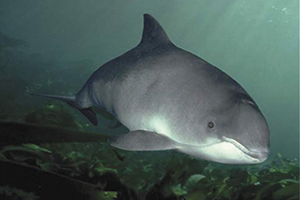 Harbor Porpoise (Phocoena phocoena) Harbor Porpoise (Phocoena phocoena)
Harbor porpoise are typically seen in our area from December to April. They are easily distinguished from dolphins because they do not have a distinct beak. They have a short robust body, short triangular dorsal fin, and a short blunt beak. Harbor porpoises can grow to 5.5 feet and weigh up to 170 pounds, with females being slightly larger than males. Young harbor porpoise are weaned after 8-12 months. A harbor porpoise has a dark gray back and white belly. Photo credit: Encylopedia Brittanica.
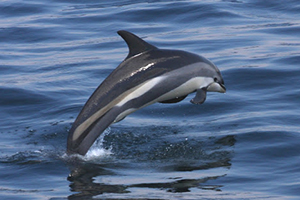 Atlantic White-Sided Dolphin (Lagenorhynchus acutus) Atlantic White-Sided Dolphin (Lagenorhynchus acutus)
The Atlantic white-sided dolphin is a year round resident of New England. They have a robust body, short beak, and tall dorsal fin and are distinguished by their distinct color pattern and bi-colored beak. They can grow to be 8.5 feet and weigh up to 500 pounds. Females give birth in June-July and they lactate for 12-18 months. They are very social and playful, are often seen in groups, and often mingle with other cetaceans such as pilot whales, humpback whales, and fin whales. Their back, flippers, fluke, and the top of their beak are black, while their belly and lower beak are white. Their sides are gray and they have a distinct yellow-tan patch on their tail stock. They also have a black stripe from the corner of their mouth to the front of the flipper. Photo credit: life-sea.blogspot.com
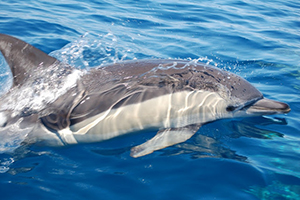 Short-Beaked Common Dolphin (Delphinus delphis) Short-Beaked Common Dolphin (Delphinus delphis)
The short-beaked common dolphin is another year round resident of New England. They have a sleak robust body, prominent beak, and tall pointed dorsal fin. They can grow to be 8 feet long and up to 440 pounds.They are found offshore in large social groups and often associate with schools of tuna and feeding flocks of seabirds. Females give birth May-July and lactation lasts for about 4 months. They have a black back and white belly, with a distinct crisscross pattern on their sides. The front/beak area of the crisscross pattern is a yellowish-tan color and back/fluke end is gray. They also have a black stripe from the corner of their mouth to the front of the flipper and a black eye patch. Photo credit: life-sea.blogspot.com
|

 Harbor Seal (Phoca vitulina)
Harbor Seal (Phoca vitulina)
 Hooded Seal (Cystophora cristata)
Hooded Seal (Cystophora cristata)
 Harbor Porpoise (Phocoena phocoena)
Harbor Porpoise (Phocoena phocoena) Atlantic White-Sided Dolphin (Lagenorhynchus acutus)
Atlantic White-Sided Dolphin (Lagenorhynchus acutus) Short-Beaked Common Dolphin (Delphinus delphis)
Short-Beaked Common Dolphin (Delphinus delphis)